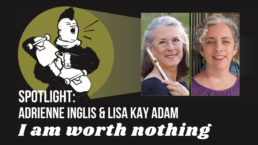Get to know Composer Adrienne Inglis & Librettist/Poet Lisa Kay Adam, creators of I am worth nothing, which is based on a solo piece commissioned by Austin-based Inversion Ensemble.

Often the most poignant and powerful dialogue happens between those who create and those who perform. That’s why OOO connects our singing-artists with the composers and librettists selected for the 6th Annual Fresh Squeezed Ounce of Opera.
So if you’re curious about the musical themes, story inspiration, what to listen for, and more, you’re in the right place.
Here, enjoy insights about I am worth nothing, written by Adrienne Inglis & Lisa Kay Adam– with questions from the cast – sure to enhance your FSOO experience.
First a quick synopsis:
I am worth nothing sets a stunning Coahuilteco/English poem by Texas poet Lisa Kay Adam. From the phrase Pīntci nakāmmam axām (I am worth nothing), Adam creates a vivid story of two young Coahuiltecan sisters and their encounters with newly arrived Spanish settlers and mission priests in the eighteenth century. Musically, the florid phrases and haunting modalities join with the sounds of drums and melancholic bells to paint a picture of exploitation, early death, and a lost way of life in the western Gulf coastal plains.
"I am worth nothing” tackles such a heavy and important subject matter. I’m curious if there was something about this specific text from Lisa Kay Adam’s book that drew you to set it to this piece.
Adrienne: I have a sister with whom I am very close. The heartbreaking death of the younger sister plus the tragic intersection of the Coahuilteco people, the mission priests, and the colonial Spaniards all drew me to Lisa’s remarkable poem. With my distant Ojibwe roots, the early eighteenth century setting in the western gulf coastal plains with a peoples whose language is now extinct also fascinated me. I should say that the poem does not explicitly say how the younger sister dies. It could easily have been disease, but her violent death is equally plausible, and arguably, more operatic. I also wanted to honor the vivid imagination and eloquence in which Lisa builds a historically informed and very powerful vignette out of a simple Coahuilteco phrase transcribed by a priest many generations ago.
Where do you see the older sister's character as she tells her story? Do you still see her involved in the church, or do you see her receiving messages of building up as opposed to tearing down?
Adrienne: The older sister strives to make sense of her changing world. She understands that she and her sister have assisted the rest of their distressed family by being traded to the Spaniard for blankets, horses, food, and more. This clear physical representation of their value made them feel helpful and worthy, even though they suffered in their new life with the Spaniard and his wife. When her sister dies, her life is again changed drastically at the cruel and violent hands of the Spaniard. Her world doesn’t make sense any more. When the priest rescues her from the Spaniard, she begins to understand her worth differently. She was not purchased by the priest, so no longer has monetary value. He taught her that not only is she worth nothing, but that she has the heavy burden of sin to carry—such a harsh authoritarian teaching. I like to think that she learns that her ability to work does not define her value, and that she is worthy no matter what. Only by God’s grace through prayer will she fly to heaven, weightless, forgiven, and freed from her sins.
Was there a particular reference point for the priest's music, or a particular vocal style you envisioned? Sounds a bit like Gregorian chant, but I'm curious if there are other influences in there as well.
Adrienne: Yes, liturgical chant absolutely influenced the priest’s part in the final section of the opera. The G minor pentatonic scale common to the Native American flute underpins the melodic material. The priest could choose to interpret the chant strictly as descended from Medieval European roots or showing some connection with the Coahuilteco people by infusing the melisma with typical Native American embellishments.

